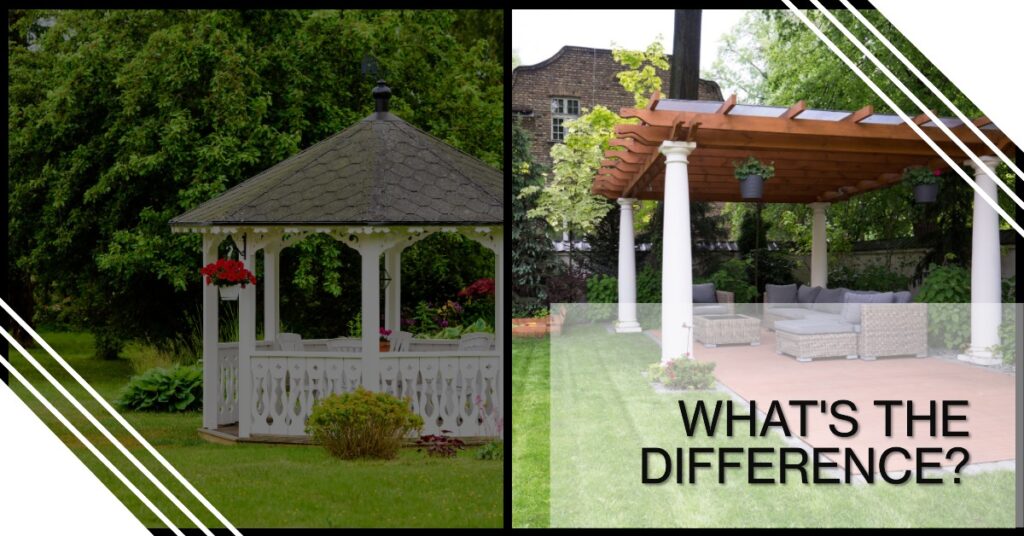When it comes to enhancing outdoor spaces, many homeowners are faced with a perplexing question: What is the difference between a gazebo and a pavilion? Both structures offer unique advantages for relaxation, entertainment, and aesthetic appeal.
However, understanding their key differences can help you make the perfect choice that suits your needs and complements your property’s design.
 Key Takeaways
Key Takeaways
- Gazebos are typically smaller, more affordable, and offer limited coverage compared to pavilions. They are great options for creating relaxation zones or intimate entertainment areas.
- Pavilions are larger in size, more expensive and have open sides that make them perfect for bigger events or functions where ample space is needed. They provide greater coverage from the elements but have limited aesthetic appeal.
- The choice between a gazebo and a pavilion depends on factors such as purpose, budget,size of outdoor space,and preferred design aesthetics.
- Both structures come in various sizes, designs, and materials like wood, metal or vinyl which offer different levels of sustainability concerns among others.
Gazebo Vs Pavilion: Understanding The Different Types Of Outdoor Structures
Gain a comprehensive understanding of the different types of outdoor structures by exploring the characteristics, definitions, and key differences between gazebos and pavilions.
Definition And Characteristics Of Gazebos
Gazebos are a popular type of outdoor structure that combine both aesthetic appeal and functionality to create inviting spaces for relaxation and entertainment. Typically characterized by their octagonal shape, these standalone shelters feature a domed roof supported by eight symmetrical pillared columns.
In addition to their distinctive architecture, gazebos offer several practical benefits as well. They provide shade from the sun’s harsh rays and protection from light rain, creating an ideal space for enjoying pleasant weather outdoors with friends or family.
Some homeowners even choose to add curtains or screens around the gazebo’s perimeter for added privacy and bug protection, transforming this quaint structure into a cozy getaway spot within their own property.
Definition And Characteristics Of Pavilions
Pavilions are outdoor structures that offer full coverage from the sun and can accommodate larger groups of people. They typically have an open design with no walls, making them ideal for hosting large events such as weddings or corporate gatherings.
One example of a pavilion is a picnic shelter found in public parks, where families gather to enjoy picnics and barbecues. Another popular use for pavilions is as event venues, where they provide covered outdoor spaces for concerts and festivals.
Key Differences Between Gazebos And Pavilions
Gazebos and pavilions have some similarities, but they also have some unique features that set them apart. Gazebos are typically smaller and more affordable than pavilions.
They usually have an octagonal shape with a domed roof supported by eight symmetrical pillared columns, while pavilions can accommodate larger groups and come in various shapes like rectangular or square with open sides.
The purpose of the structures is also different; gazebos are often used for relaxation or as small entertainment areas, while pavilions provide greater coverage for larger gatherings or events.
Roof Design, Purpose, Size, And Price
When it comes to roof design, gazebos can have an open or enclosed roof, while pavilions typically have an open design; purpose-wise, gazebos are usually used for relaxation and entertainment, while pavilions offer shelter for larger groups; size and capacity-wise, gazebos are smaller than pavilions; price-wise, gazebos tend to be more affordable compared to their larger counterparts.
Roof Design: Open Vs Enclosed
The roof design is one of the key differences between gazebos and pavilions. Gazebos usually have enclosed roofs, providing complete coverage from sun or rain, making it a perfect space for relaxation and intimate gatherings.
On the other hand, pavilions generally feature open roofs that allow air to circulate freely while still offering some shade protection. This makes them ideal for large events such as weddings and picnics where guests need room to move around without feeling confined.
Purpose: Entertainment Vs Shelter
Both gazebos and pavilions serve different purposes depending on what you need them for. Gazebos are generally used to create a relaxation zone or an entertainment area for small groups of people.
They provide shelter from the sun while still giving you an outdoor experience, making it perfect for hosting intimate gatherings with friends and family. On the other hand, pavilions offer full coverage from the sun and can accommodate larger groups of people during events like weddings, receptions, or corporate functions.
So when considering which outdoor structure is best suited for your needs, think about whether you want something that provides more entertainment value versus one meant mainly for sheltering large numbers of people.
Size And Capacity: Small Vs Large
Gazebos and pavilions differ in terms of size and capacity. Gazebos are typically smaller than pavilions, making them an ideal choice for small gatherings or as a cozy relaxation zone.
They can accommodate up to six people comfortably but may not be suitable for larger events or parties. Pavilions, on the other hand, are much larger than gazebos and can accommodate bigger groups of people while providing ample space for entertainment purposes such as hosting picnics or barbeques.
The large size of pavilions makes them perfect for weddings, corporate events, or community gatherings that require plenty of space to accommodate guests comfortably.
Price: Affordable Vs Expensive
When it comes to price, gazebos are generally considered more affordable than pavilions. Gazebos come in a range of sizes and designs, allowing for a variety of price points depending on the materials used and the level of craftsmanship.
Pavilions, on the other hand, are usually more expensive due to their larger size and greater coverage area. While they offer greater protection from the elements and can accommodate larger groups of people for events, this added functionality often comes with higher costs.
Prices for pavilions typically start at around $5,000 but can easily reach upwards of $20,000 depending on factors like size and design complexity.
Pros And Cons Of Gazebos Vs Pavilions
When it comes to choosing between a gazebo and a pavilion, it’s important to consider the pros and cons of each. Gazebos offer aesthetic appeal and affordability but have limited coverage and space, while pavilions provide greater coverage and larger size but come with a higher price tag.
Gazebos: Aesthetic Appeal, More Affordable, Limited Coverage, Less Space
Gazebos, with their octagonal shape and domed roofs supported by symmetrical pillared columns, are known for their aesthetic appeal. They add a touch of elegance to any outdoor space and come in various sizes to accommodate different needs.
Additionally, gazebos tend to be more affordable than pavilions, making them an excellent choice for those on a budget. However, one drawback of gazebos is that they offer limited coverage compared to pavilions as they have open sides.
This means that they may not provide enough shelter during heavy rains or windy weather conditions where additional protection is needed. Nevertheless, with the addition of shade canopies and curtains, gazebos can still provide adequate protection while maintaining their beautiful appearance.
Overall, when considering choosing between a gazebo or pavilion for your outdoor space, it’s essential to weigh the pros and cons carefully based on your specific requirements such as size constraints or entertainment purposes.
Pavilions: Larger Size, Greater Coverage, More Expensive, Limited Aesthetic Appeal
Pavilions are a great option for those needing larger covered outdoor space. Typically, pavilions provide greater coverage than gazebos since they have open sides and often do not feature side panels or screens.
However, unlike gazebos, pavilions tend to have limited aesthetic appeal due to their basic design and lack of intricate details like domed roofs or symmetrical columns.
Despite being less visually attractive than some other options, a pavilion can be an ideal choice for hosting large parties or events where plenty of space is needed. Its size and spaciousness allow it to accommodate larger groups comfortably while providing adequate shade from the sun’s glare.
Choosing Between A Gazebo And A Pavilion
When deciding between a gazebo and a pavilion, it is important to determine your needs and purpose, evaluate your budget, consider the size of your outdoor space, think about the style and design you prefer, and explore different materials.
Determine Your Needs And Purpose
To choose between a gazebo and a pavilion, it’s essential to determine your needs and purpose for the outdoor structure. Ask yourself questions like, “Will I be using this space for relaxation or entertainment?” and “How many people will typically be using it at once?” If you’re looking for a smaller space to relax in, a gazebo might be the better option.
Additionally, consider the style and design of your outdoor space. Gazebos are often octagonal with symmetrical pillared columns and domed roofs that add an aesthetic appeal to gardens or patios.
In contrast, pavilions tend to have more straightforward designs but provide greater coverage from the elements.
Evaluate Your Budget
Before deciding on whether to get a gazebo or a pavilion, it is essential to evaluate your budget carefully. Gazebos tend to be more affordable compared to pavilions due to their smaller size and simpler design.
On the other hand, pavilions can accommodate larger groups of people and provide greater coverage from the sun.
Consider your available finances and weigh the pros and cons of each structure carefully. If you are looking for a smaller outdoor space that provides aesthetic appeal and relaxation zones but also remains within a tight budget, then gazebos could be an excellent choice for you.
Consider The Size Of Your Outdoor Space
When choosing between a gazebo and a pavilion, it is essential to consider the size of your outdoor space. A small garden or backyard may not be able to accommodate a large pavilion, while a gazebo can fit comfortably in most smaller areas.
On the other hand, if you have ample outdoor space and regularly host events or gatherings with larger groups of people, then a pavilion could be the perfect option for you.
It’s important to note that both structures come in various sizes and designs, so it’s best to carefully evaluate your available space before making any final decisions.
Think About The Style And Design
When it comes to choosing between a gazebo and a pavilion, considering the style and design is crucial. Gazebos are known for their aesthetics, featuring an octagon shape and domed roof supported by eight symmetrical pillared columns.
On the other hand, pavilions are often more basic in design but offer greater coverage for larger groups of people. They typically have simple support structures with open sides that provide ample room for events or entertaining guests.
Remember that there are various options available when it comes to selecting the right outdoor structure for you – from size to materials used in construction – so take time to explore all possibilities before making a final decision.
Explore Different Materials
Another important aspect to consider when choosing between a gazebo and a pavilion is the materials used in their construction. Both come in a variety of materials, including wood, metal, and vinyl.
Wood gazebos are popular for their natural warm appearance, while metal structures may require less maintenance.
Pavilions can also be constructed using different types of wood such as cedar or redwood which provide natural beauty that lasts longer than other varieties.
In summary, deciding on the appropriate material choice will depend on your budget as well as other preferences like aesthetics and sustainability concerns among others.
Conclusion
In conclusion, gazebos and pavilions offer great options for creating covered outdoor spaces. Gazebos are smaller and more affordable, perfect for relaxing or entertaining small groups.
Pavilions, on the other hand, are larger in size and have open sides which make them ideal for bigger events or functions. When choosing between the two structures, it is important to consider factors such as budget, purpose, size of outdoor space and overall design aesthetics.
Related Posts
How to keep birds out of my gazebo
Can you put solar panels on a gazebo
Where to put a gazebo in the backyard
How to keep a gazebo from blowing away
How to hang lights in a gazebo
How to hang gazebo curtains
How to screen a gazebo
How to level a gazebo on sloped concrete
What to do with an old metal gazebo frame
How to move a gazebo
Do you need a permit for a gazebo
How to build a gazebo on a deck
How to anchor a gazebo without drilling
How to decorate a gazebo for a wedding
How much does a gazebo cost
How to build a gazebo roof
What is a gazebo used for
What is the difference between a gazebo and pergola


 Key Takeaways
Key Takeaways



